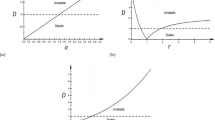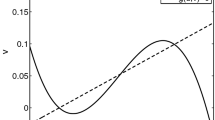Abstract
It is well established that in problems featuring slow passage through a Hopf bifurcation (dynamic Hopf bifurcation) the transition to large-amplitude oscillations may not occur until the slowly changing parameter considerably exceeds the value predicted from the static Hopf bifurcation analysis (temporal delay effect), with the length of the delay depending upon the initial value of the slowly changing parameter (temporal memory effect). In this paper we introduce new delay and memory effect phenomena using both analytic (WKB method) and numerical methods. We present a reaction–diffusion system for which slowly ramping a stimulus parameter (injected current) through a Hopf bifurcation elicits large-amplitude oscillations confined to a location a significant distance from the injection site (spatial delay effect). Furthermore, if the initial current value changes, this location may change (spatial memory effect). Our reaction–diffusion system is Baer and Rinzel’s continuum model of a spiny dendritic cable; this system consists of a passive dendritic cable weakly coupled to excitable dendritic spines. We compare results for this system with those for nerve cable models in which there is stronger coupling between the reactive and diffusive portions of the system. Finally, we show mathematically that Hodgkin and Huxley were correct in their assertion that for a sufficiently slow current ramp and a sufficiently large cable length, no value of injected current would cause their model of an excitable cable to fire; we call this phenomenon “complete accommodation.”














Similar content being viewed by others
References
Baer SM, Gaekel EM (2008) Slow acceleration and deacceleration through a Hopf bifurcation: power ramps, target nucleation, and elliptic bursting. Phys Rev E 78:036205
Baer SM, Rinzel J (1991) Propagation of dendritic spikes mediated by excitable spines: a continuum theory. J Neurophysiol 65:874–890
Baer SM, Erneux T, Rinzel J (1989) The slow passage through a Hopf bifurcation: delay, memory effects, and resonance. SIAM J Appl Math 49:55–71
Bilinsky LM (2012) Dynamic Hopf bifurcation in spatially extended excitable systems from neuroscience. Ph.D. thesis, Arizona State University, Tempe, AZ
Chen YX, Kolokolnikov T, Tzou J, Gai CY (2015) Patterned vegetation, tipping points, and the rate of climate change. Eur J Appl Math 26:945–958
Cooley JW, Dodge FA (1966) Digital computer solutions for excitation and propagation of nerve impulse. Biophys J 6:583–599
Doedel EJ (1981) AUTO, a program for the automatic bifurcation analysis of autonomous systems. Cong Numer 30:265–384
du Bois-Reymond E (1849) Untersuchungen ueber thierische Elektricitaet. G. Reimer
Hayes MG, Kaper TJ, Szmolyan P, Wechselberger M (2015) Geometric desingularization of degenerate singularities in the presence of fast rotation: a new proof of known results for slow passage through Hopf bifurcations. Indagationes Math. https://doi.org/10.1016/j.indag.2015.11.005
Hodgkin AL, Huxley AF (1952) A quantitative description of membrane current and its application to conduction and excitation in nerve. J Physiol Lond 117:500–544
Jakobsson E, Guttman R (1980) The standard Hodgkin–Huxley model and squid axons in reduced external \(C^{++}\) fail to accommodate to slowly rising currents. Biophys J 31:293–298
Keener J, Sneyd J (1998) Mathematical physiology. Springer, Berlin
Kovalsky Y, Amir R, Devor M (2008) Subthreshold oscillations facilitate neuropathic spike discharge by overcoming membrane accommodation. Exp Neurol 210:194–206
Kuske R (1999) Probability densities for noisy delay bifurcations. J Stat Phys 96:797–816
Kuske R, Baer SM (2002) Asymptotic analysis of noise sensitivity in a neuronal burster. Bull Math Biol 64:447–481
Lester RAJ, Clements JD, Westbrook GL, Jahr CE (1990) Channel kinetics determine the time course of NMDA receptor-mediated synaptic currents. Nature 346:565–567
Neishtadt AI (1987) Persistence of stability loss for dynamical bifurcations I. Differ Equ 23:1385–1391
Rinzel J, Baer SM (1988) Threshold for repetitive activity for a slow stimulus ramp. Biophys J 54:551–555
Rinzel J, Keener JP (1983) Hopf bifurcation to repetitive activity in nerve. SIAM J Appl Math 43:907–921
Segev I, Rall W (1988) Computational study of an excitable dendritic spine. J Neurophysiol 60:499–523
Sobel SG, Hastings HM, Field RJ (2006) Oxidation state of BZ reaction mixtures. J Phys Chem A 110:5–7
Strizhak P, Menzinger M (1996) Slow passage through a supercritical hopf bifurcation: time-delayed response in the belousov-zhabotinsky reaction in a batch reactor. J Chem Phys 105:10905–10910
Su J (1994) On delayed oscillation in nonspatially uniform Fitzhugh–Nagumo equation. J Differ Equ 110:38–52
Su J (2003) Effects of noise on elliptic bursters. Nonlinearity 17:133–157
Tzou JC, Ward MJ, Kolokolnikov T (2015) Slowly varying control parameters, delayed bifurcations, and the stability of spikes in reaction-diffusion systems. Phys D 290:24–43
Vallbo AB (1964) Accommodation related to inactivation of sodium permeability in single myelinated nerve fibres from Xenopus laevis. Acta Physiol Scand 61:429–444
Verzi DW, Rheuben MB, Baer SM (2005) Impact of time-dependent changes in spine density and spine shape on the input–output properties of a dendritic branch: a computational study. J Neurophysiol 93:2073–2089
Vo T, Tabak J, Bertram R, Wechselberger M (2014) A geometric understanding of how fast activating potassium channels promote bursting in pituitary cells. J Comput Neurosci 36:259–278
Younghae D, Lopez JM (2013) Slow passage through multiple bifurcation points. Discrete Contin Dyn Syst Ser B 18:95–107
Zhou Y (1998) Unique wave front for dendritic spines with Nagumo dynamics. Math Biosci 148:205–225
Author information
Authors and Affiliations
Corresponding author
Rights and permissions
About this article
Cite this article
Bilinsky, L.M., Baer, S.M. Slow Passage Through a Hopf Bifurcation in Excitable Nerve Cables: Spatial Delays and Spatial Memory Effects. Bull Math Biol 80, 130–150 (2018). https://doi.org/10.1007/s11538-017-0366-2
Received:
Accepted:
Published:
Issue Date:
DOI: https://doi.org/10.1007/s11538-017-0366-2




